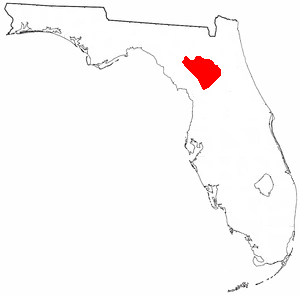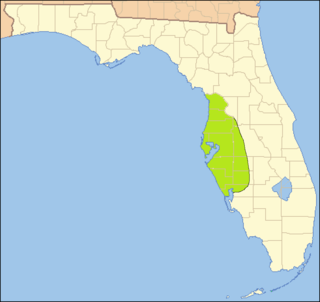
Ceramics of Indigenous peoples of the Americas is an art form with at least a 7500-year history in the Americas. Pottery is fired ceramics with clay as a component. Ceramics are used for utilitarian cooking vessels, serving and storage vessels, pipes, funerary urns, censers, musical instruments, ceremonial items, masks, toys, sculptures, and a myriad of other art forms.
Tocobaga was the name of a chiefdom of Native Americans, its chief, and its principal town during the 16th century. The chiefdom was centered around the northern end of Old Tampa Bay, the arm of Tampa Bay that extends between the present-day city of Tampa and northern Pinellas County. The exact location of the principal town is believed to be the archeological Safety Harbor site. This is the namesake for the Safety Harbor culture, of which the Tocobaga are the most well-known group.

The Windover Archeological Site is a Middle Archaic archaeological site and National Historic Landmark in Brevard County near Titusville, Florida, United States on the central east coast of the state. Windover is a muck pond where skeletal remains of 168 individuals were found buried in the peat at the bottom of the pond. The skeletons were well preserved because of the peat. In addition, remarkably well-preserved brain tissue has been recovered from 91 skulls from the site. DNA from the brain tissue has been sequenced. The collection of human skeletal remains and artifacts recovered from Windover Pond represent among the largest finds of each type from the Archaic Period. It is considered one of the most important archeological sites ever excavated.

The Weeden Island cultures are a group of related archaeological cultures that existed during the Late Woodland period of the North American Southeast. The name for this group of cultures was derived from the Weedon Island site in Old Tampa Bay in Pinellas County.

The Alachua culture is a Late Woodland Southeast period archaeological culture in north-central Florida, dating from around 600 to 1700. It is found in an area roughly corresponding to present-day Alachua County, the northern half of Marion County and the western part of Putnam County. It was preceded by the Cades Pond culture, which inhabited approximately the same area.

The Cades Pond culture is defined as a Middle Woodland Southeast period archaeological culture in north-central Florida, dating from around 100 to 600 CE.
The Belle Glade culture, or Okeechobee culture, is an archaeological culture that existed from as early as 1000 BCE until about 1700 CE in the area surrounding Lake Okeechobee and in the Kissimmee River valley in the Florida Peninsula.
The Glades culture is an archaeological culture in southernmost Florida that lasted from about 500 BCE until shortly after European contact. Its area included the Everglades, the Florida Keys, the Atlantic coast of Florida north through present-day Martin County and the Gulf coast north to Marco Island in Collier County. It did not include the area around Lake Okeechobee, which was part of the Belle Glade culture.
Jerald T. Milanich is an American anthropologist and archaeologist, specializing in Native American culture in Florida. He is Curator Emeritus of Archaeology at the Florida Museum of Natural History at the University of Florida in Gainesville; Adjunct Professor, Department of Anthropology, College of Arts and Sciences at the University of Florida; and Adjunct Professor, Center for Latin American Studies at the University of Florida. Milanich holds a Ph.D in anthropology from the University of Florida.
The Big Mound Key-Boggess Ridge Archeological District is a historic site near Placida, Florida. It is located southeast of Placida, on Big Mound Key. On December 3, 1990, it was added to the U.S. National Register of Historic Places.

Mount Royal (8PU35) is a U.S. archaeological site close to where the St. Johns River exits from Lake George in Putnam County, Florida. It is located three miles (5 km) south of Welaka, in the Mount Royal Airpark, off County Road 309 on the eastern bank of the St. Johns River. The site consists of a large sand mound and several nearby middens.

The Deptford culture was an archaeological culture in southeastern North America characterized by the appearance of elaborate ceremonial complexes, increasing social and political complexity, mound burial, permanent settlements, population growth, and an increasing reliance on cultigens.

The Santa Rosa–Swift Creek culture was characterized by the appearance of elaborate ceremonial complexes, increasing social and political complexity, mound burial, permanent settlements, population growth, and an increasing reliance on cultigens. "Santa Rosa" is associated with the archeological site Santa Rosa Island, Santa Rosa County, Florida. "Swift Creek" is associated with the archeological site near Swift Creek, Bibb County, Georgia.
The indigenous peoples of Florida lived in what is now known as Florida for more than 12,000 years before the time of first contact with Europeans. However, the indigenous Floridians living east of the Apalachicola River had largely died out by the early 18th century. Some Apalachees migrated to Louisiana, where their descendants now live; some were taken to Cuba and Mexico by the Spanish in the 18th century, and a few may have been absorbed into the Seminole and Miccosukee tribes.

The Safety Harbor culture was an archaeological culture practiced by Native Americans living on the central Gulf coast of the Florida peninsula, from about 900 CE until after 1700. The Safety Harbor culture is defined by the presence of Safety Harbor ceramics in burial mounds. The culture is named after the Safety Harbor site, which is close to the center of the culture area. The Safety Harbor site is the probable location of the chief town of the Tocobaga, the best known of the groups practicing the Safety Harbor culture.
The Orange period or Orange culture was a late-Archaic archaeological culture along the eastern side of the Florida peninsula, from about 4,000 years ago to about 2,500 or 3,000 years ago. The Orange period is largely defined by the presence of Orange-series fiber-tempered pottery.
The Mount Taylor period or Mount Taylor culture was a pre-ceramic archaeological culture in northeastern Florida in the middle to late Archaic period. The Mount Taylor period lasted from approximately 5000 or 4000 BCE to 2000 BCE. Most archaeological sites associated with the culture are in the middle and upper parts of the St. Johns River valley, with related sites occurring along the east coast of Florida, and at a few other places in Florida. The Mount Taylor culture emerged from the regionally undifferentiated middle Archaic culture in Florida, and was succeeded by the late Archaic Orange period.
The Suwannee Valley culture is defined as a Late Woodland Southeast period archaeological culture in north Florida, dating from around 750 to European contact. The core area of the culture was found in an area roughly corresponding to present-day Suwannee and southern and central Columbia counties. It was preceded by the McKeithen Weeden Island culture and followed by the Spanish mission period Leon-Jefferson culture.
The Myakkahatchee Creek Archaeological Site (8SO397) is located in North Port in Sarasota County, Florida, United States. The site was discovered when the area was being prepared for housing in 1982. Crews building Cold Springs Lane and Reiterstown Road unearthed artifacts and human remains. Archaeologists discovered a rare inland multi-period Manasota Indian village near the Myakkahatchee Creek, a major transportation route from the Gulf of Mexico inland. What makes the site so rare is that evidence of 10,000 years of occupation was excavated and very little is known about inland villages. The Manasota people remained permanently settled as fishing–hunter–gatherers between Tampa Bay and Charlotte Harbor on the Gulf Coast of Florida. Culturally, they were the northernmost of the Glades south Florida culture region. Archaeologists found a large midden, as well as a large U-shaped ritual earthwork with a burial mound. The area has yet to be professionally excavated. The creek is now part of North Ports Myakkahatchee Creek Environmental Park.
The Roberts Island complex is an archaeological site in Citrus County, Florida, near the Gulf of Mexico, dating from the late Woodland period. It is located on an island in the Crystal River midway between the springs at the head of the river and the mouth of the river on the Gulf of Mexico. The site is a geographically separate unit of the Crystal River Archaeological State Park. The site includes three shell mounds and three middens. Two of the mounds may have had stepped sides. The Roberts Island complex was developed as the Crystal River site declined and most other ceremonial sites in the region were abandoned during the 7th or 8th century.









